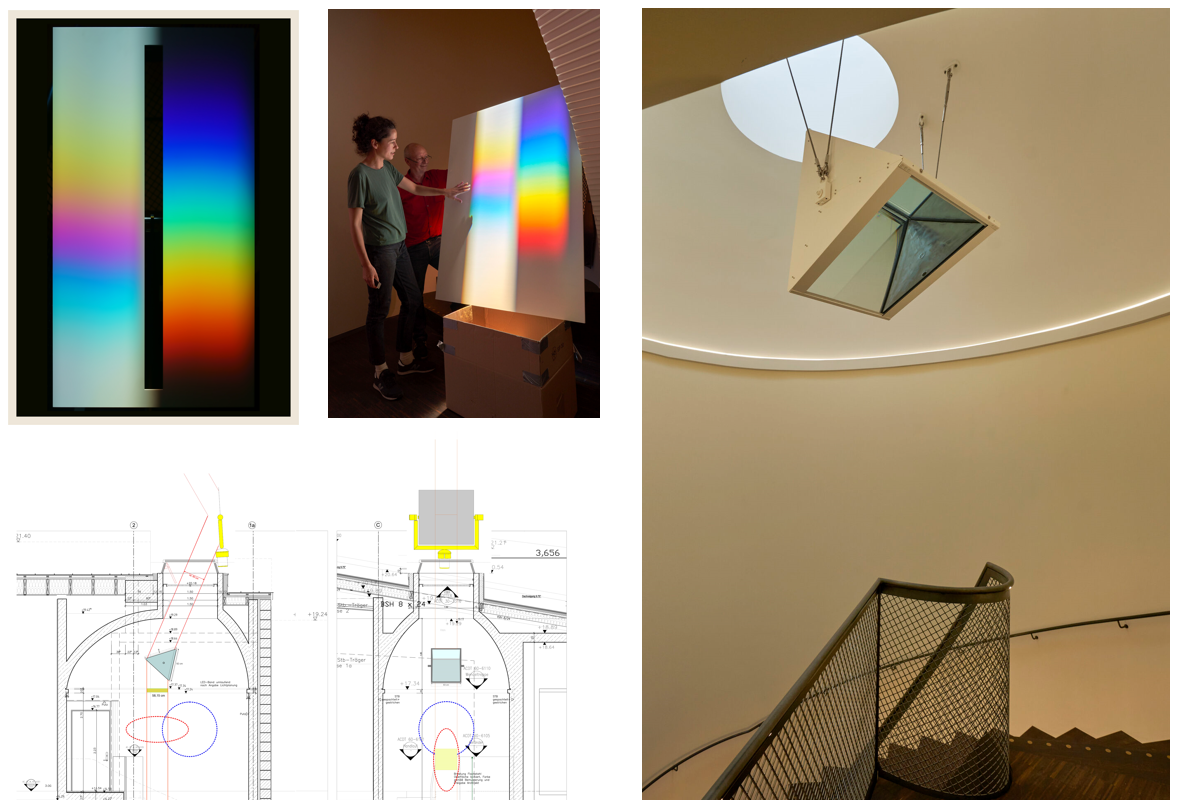The Rainbow’s Missing Colours
An artistic, scientific staging by the Viennese artist Ingo Nussbaumer. In the newly built German Romantic Museum, in the middle of the old town of Frankfurt am Main and in the immediate vicinity of Goethe’s birthplace, the work “Light Night of the Iris” was created. Ingo Nussbaumer adheres to the thesis of the inverted spectrum of light thrown into the discussion by Johann Wolfgang von Goethe. With the help of Lumenas heliostat, a prism and a specially designed template, he presents Goethe’s spectrum next to Newton’s spectrum. A technical device that Goethe did not have at his disposal in the 19th century. The special feature of the installation is the unprecedented size of the prism. The prismatic glass body, filled with water, hangs below a dome through which the heliostat directs sunlight at a defined angle. The size of the prism allows the two spectra to appear side by side in breathtaking beauty.
In ancient times, the rainbow was considered a symbol of Iris, the messenger of the gods. As is well known, its colours can be conjured up in the dark from a narrow beam of sunlight by means of a prism; Newton discovered this in 1666, thus creating the basis for the optics that are valid today. That it also works the other way around is less well known. It was none other than Goethe who brought this opposite experiment into the limelight, campaigned against Newton’s one-sided preference for light, and thus inspired the romantic friends of the night. Newton’s spectrum was thus given a spectral counterpart: the Goethe spectrum.
Technical implementation and installation: Lumena 2021


The Rainbow’s Missing Colours
An artistic, scientific staging by the Viennese artist Ingo Nussbaumer. In the newly built German Romantic Museum, in the middle of the old town of Frankfurt am Main and in the immediate vicinity of Goethe’s birthplace, the work “Light Night of the Iris” was created. Ingo Nussbaumer adheres to the thesis of the inverted spectrum of light thrown into the discussion by Johann Wolfgang von Goethe. With the help of Lumenas heliostat, a prism and a specially designed template, he presents Goethe’s spectrum next to Newton’s spectrum. A technical device that Goethe did not have at his disposal in the 19th century. The special feature of the installation is the unprecedented size of the prism. The prismatic glass body, filled with water, hangs below a dome through which the heliostat directs sunlight at a defined angle. The size of the prism allows the two spectra to appear side by side in breathtaking beauty.
In ancient times, the rainbow was considered a symbol of Iris, the messenger of the gods. As is well known, its colours can be conjured up in the dark from a narrow beam of sunlight by means of a prism; Newton discovered this in 1666, thus creating the basis for the optics that are valid today. That it also works the other way around is less well known. It was none other than Goethe who brought this opposite experiment into the limelight, campaigned against Newton’s one-sided preference for light, and thus inspired the romantic friends of the night. Newton’s spectrum was thus given a spectral counterpart: the Goethe spectrum.
Technical implementation and installation: Lumena 2021


